Dentin Bonding Performance of Universal Adhesives in Primary Teeth In Vitro
Abstract
:1. Introduction
2. Materials and Methods
3. Results
4. Discussion
5. Conclusions
Author Contributions
Funding
Institutional Review Board Statement
Informed Consent Statement
Data Availability Statement
Conflicts of Interest
References
- Frencken, J.E.; Sharma, P.; Stenhouse, L.; Green, D.; Laverty, D.; Dietrich, T. Global epidemiology of dental caries and severe periodontitis—A comprehensive review. J. Clin. Periodontol. 2017, 44 (Suppl. 18), S94–S105. [Google Scholar] [CrossRef] [PubMed]
- Krämer, N.; Frankenberger, R. Restorative therapy in deciduous teeth. Oralprophyl. Kinderzahnheilkd 2004, 26, 78–84. [Google Scholar]
- Meereis, C.T.W.; Münchow, E.A.; de Oliveira da Rosa, W.L.; da Silva, A.F.; Piva, E. Polymerization shrinkage stress of resin-based dental materials: A systematic review and meta-analyses of composition strategies. J. Mech. Behav. Biomed. Mater. 2018, 82, 268–281. [Google Scholar] [CrossRef] [PubMed]
- Peumans, M.; Kanumilli, P.; De Munck, J.; Van Landuyt, K.; Lambrechts, P.; Van Meerbeek, B. Clinical effectiveness of contemporary adhesives: A systematic review of current clinical trials. Dent. Mater. 2005, 21, 864–881. [Google Scholar] [CrossRef] [PubMed]
- da Silva, C.L.; Cavalheiro, C.P.; Gimenez, T.; Imparato, J.C.P.; Bussadori, S.K.; Lenzi, T.L. Bonding Performance of Universal and Contemporary Adhesives in Primary Teeth: A Systematic Review and Network Meta-Analysis of In Vitro Studies. Pediatr. Dent. 2021, 43, 170–177. [Google Scholar] [PubMed]
- Fröhlich, T.T.; Gindri, L.D.; Soares, F.Z.M.; de Oliveira Rocha, R. Does the etching strategy influence the bonding of universal adhesive systems to primary teeth? A systematic review and meta-analysis of in vitro studies. Eur. Arch. Paediatr. Dent. 2021, 22, 1015–1022. [Google Scholar] [CrossRef] [PubMed]
- Fujita-Nakajima, K.; Aoki-Tabei, N.; Arita, A.; Nishiyama, N. NMR study on the demineralization mechanism of the enamel and dentin surfaces in MDP-based all-in-one adhesive. Dent. Mater. J. 2018, 37, 693–701. [Google Scholar] [CrossRef]
- Yoshihara, K.; Yoshida, Y.; Hayakawa, S.; Nagaoka, N.; Irie, M.; Ogawa, T.; van Landuyt, K.L.; Osaka, A.; Suzuki, K.; Minag, S.; et al. Nanolayering of phosphoric acid ester monomer on enamel and dentin. Acta Biomater. 2011, 7, 3187–3195. [Google Scholar] [CrossRef]
- Feitosa, V.P.; Sauro, S.; Ogliari, F.A.; Ogliari, A.O.; Yoshihara, K.; Zanchi, C.H.; Correr-Sobrinho, L.; Sinhoreti, M.A.; Correr, A.B.; Watson, T.F.; et al. Impact of hydrophilicity and length of spacer chains on the bonding of functional monomers. Dent. Mater. 2014, 30, e317–e323. [Google Scholar] [CrossRef]
- Inoue, S.; Koshiro, K.; Yoshida, Y.; de Munck, J.; Nagakane, K.; Suzuki, K.; Sano, H.; Van Meerbeek, B. Hydrolytic stability of self-etch adhesives bonded to dentin. J. Dent. Res. 2005, 84, 1160–1164. [Google Scholar] [CrossRef]
- Bücher, K.; Metz, I.; Pitchika, V.; Hickel, R.; Kühnisch, J. Survival characteristics of composite restorations in primary teeth. Clin. Oral Investig. 2015, 19, 1653–1662. [Google Scholar] [CrossRef] [PubMed]
- Amend, S.; Frankenberger, R.; Oschmann, T.; Lücker, S.; Winter, J.; Krämer, N. Long-term microtensile bond strength of self-etch adhesives and influence of 7-s phosphoric acid etching on adhesion of a 3-step etch-and-rinse adhesive to the dentine of primary teeth. Int. J. Paediatr. Dent. 2022, 32, 649–659. [Google Scholar] [CrossRef] [PubMed]
- Chimeli, T.B.C.; D’Alpino, P.H.P.; Pereira, P.N.; Hilgert, L.A.; Di Hipólito, V.; Garcia, F.C.P. Effects of solvent evaporation on water sorption/solubility and nanoleakage of adhesive systems. J. Appl. Oral Sci. Rev. 2014, 22, 294–301. [Google Scholar] [CrossRef] [PubMed]
- Mithiborwala, S.; Chaugule, V.; Munshi, A.K.; Patil, V. A comparison of the resin tag penetration of the total etch and the self-etch dentin bonding systems in the primary teeth: An in vitro study. Contemp. Clin. Dent. 2012, 3, 158–163. [Google Scholar] [CrossRef] [PubMed]
- Agostini, F.G.; Kaaden, C.; Powers, J.M. Bond strength of self-etching primers to enamel and dentin of primary teeth. Pediatr. Dent. 2001, 23, 481–486. [Google Scholar] [PubMed]
- Van Meerbeek, B.; Yoshihara, K.; Yoshida, Y.; Mine, A.; de Munck, J.; Van Landuyt, K.L. State of the art of self-etch adhesives. Dent. Mater. 2011, 27, 17–28. [Google Scholar] [CrossRef]
- Sumikawa, D.A.; Marshall, G.W.; Gee, L.; Marshall, S.J. Microstructure of primary tooth dentin. Pediatr. Dent. 1999, 21, 439–444. [Google Scholar]
- Krämer, N.; Tilch, D.; Lücker, S.; Frankenberger, R. Status of ten self-etch adhesives for bonding to dentin of primary teeth. Int. J. Paediatr. Dent. 2014, 24, 192–199. [Google Scholar] [CrossRef]
- Osorio, R.; Yamauti, M.; Ruiz-Requena, M.E.; Toledano, M. MMPs activity and bond strength in deciduous dentine-resin bonded interfaces. J. Dent. 2013, 41, 549–555. [Google Scholar] [CrossRef]
- Tian, F.-C.; Wang, X.-Y.; Huang, Q.; Niu, L.-N.; Mitchell, J.; Zhang, Z.-Y.; Prananik, C.; Zhang, L.; Chen, J.-H.; Breshi, L.; et al. Effect of nanolayering of calcium salts of phosphoric acid ester monomers on the durability of resin-dentin bonds. Acta Biomater. 2016, 38, 190–200. [Google Scholar] [CrossRef]
- van Landuyt, K.L.; Yoshida, Y.; Hirata, I.; Snauwaert, J.; de Munck, J.; Okazaki, M.; Suzuki, K.; Lambrechts, P.; Van Meerbeek, B. Influence of the chemical structure of functional monomers on their adhesive performance. J. Dent. Res. 2008, 87, 757–761. [Google Scholar] [CrossRef] [PubMed]
- Van Meerbeek, B.; Yoshihara, K.; van Landuyt, K.; Yoshida, Y.; Peumans, M. From Buonocore’s Pioneering Acid-Etch Technique to Self-Adhering Restoratives. A Status Perspective of Rapidly Advancing Dental Adhesive Technology. J. Adhes. Dent. 2020, 22, 7–34. [Google Scholar] [CrossRef] [PubMed]
- Tjäderhane, L.; Palosaari, H.; Wahlgren, J.; Larmas, M.; Sorsa, T.; Salo, T. Human odontoblast culture method: The expression of collagen and matrix metalloproteinases (MMPs). Adv. Dent. Res. 2001, 15, 55–58. [Google Scholar] [CrossRef] [PubMed]
- Nagase, H.; Woessner, J.F. Matrix Metalloproteinases. J. Biol. Chem. 1999, 274, 21491–21494. [Google Scholar] [CrossRef] [PubMed]
- Niu, L.N.; Zhang, L.; Jiao, K.; Li, F.; Ding, Y.X.; Wang, D.Y.; Wang, M.Q.; Tay, F.R.; Chen, J.H. Localization of MMP-2; MMP-9; TIMP-1; and TIMP-2 in human coronal dentine. J. Dent. 2011, 39, 536–542. [Google Scholar] [CrossRef] [PubMed]
- Hedenbjörk-Lager, A.; Hamberg, K.; Pääkkönen, V.; Tjäderhane, L.; Ericson, D. Collagen degradation and preservation of MMP-8 activity in human dentine matrix after demineralization. Arch. Oral Biol. 2016, 68, 66–72. [Google Scholar] [CrossRef] [PubMed]
- Can-Karabulut, D.C.; Oz, F.T.; Karabulut, B.; Batmaz, I.; Ilk, O. Adhesion to primary and permanent dentin and a simple model approach. Eur. J. Dent. 2009, 3, 32–41. [Google Scholar] [CrossRef]
- Frassetto, A.; Breschi, L.; Turco, G.; Marchesi, G.; Di Lenarda, R.; Tay, F.R.; Pashley, D.H.; Cadenaro, M. Mechanisms of degradation of the hybrid layer in adhesive dentistry and therapeutic agents to improve bond durability—A literature review. Dent. Mater. 2016, 32, 41–53. [Google Scholar] [CrossRef]
- Choi, A.-N.; Lee, J.-H.; Son, S.-A.; Jung, K.-H.; Kwon, Y.H.; Park, J.-K. Effect of Dentin Wetness on the Bond Strength of Universal Adhesives. Materials 2017, 10, 1224. [Google Scholar] [CrossRef]
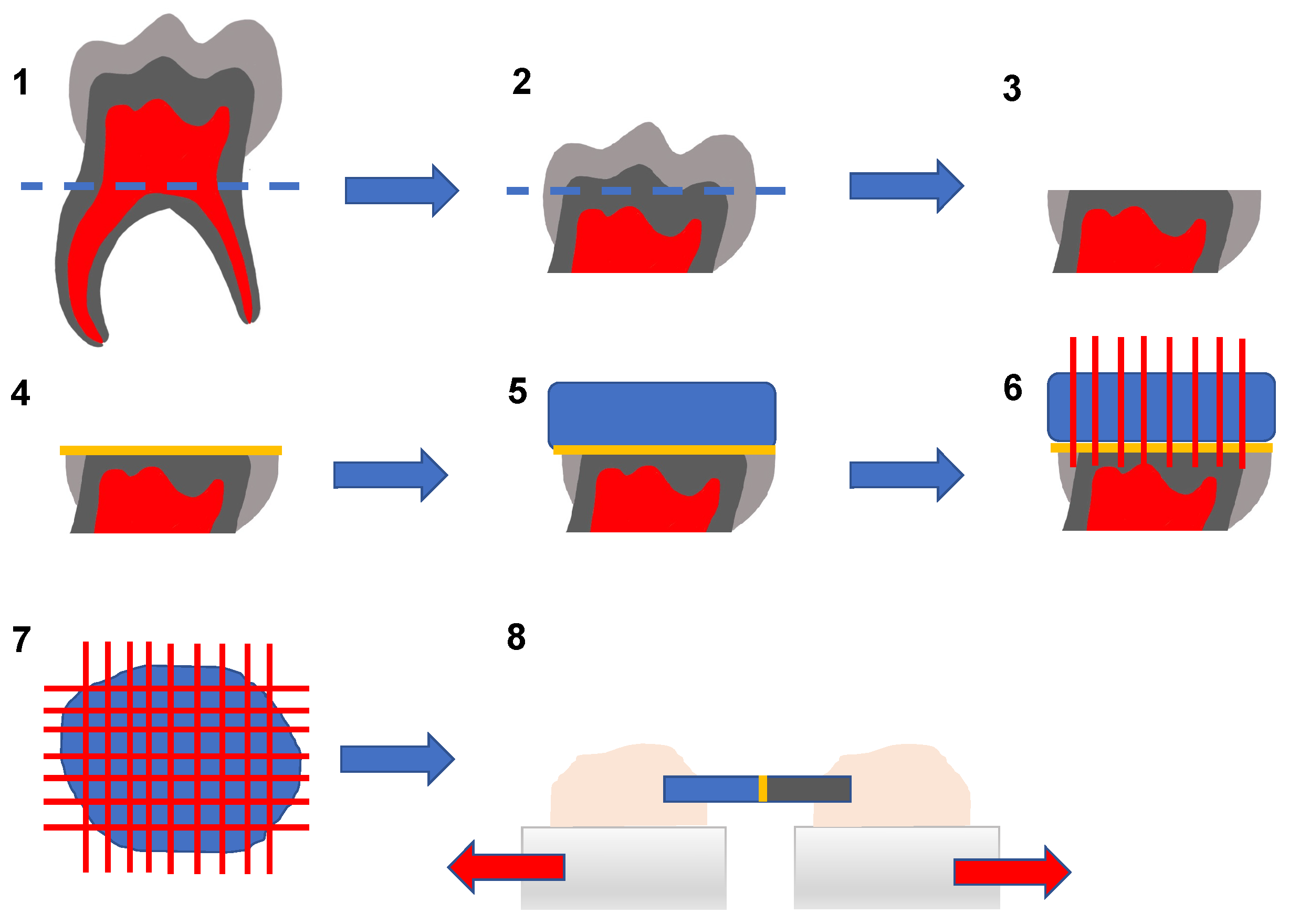
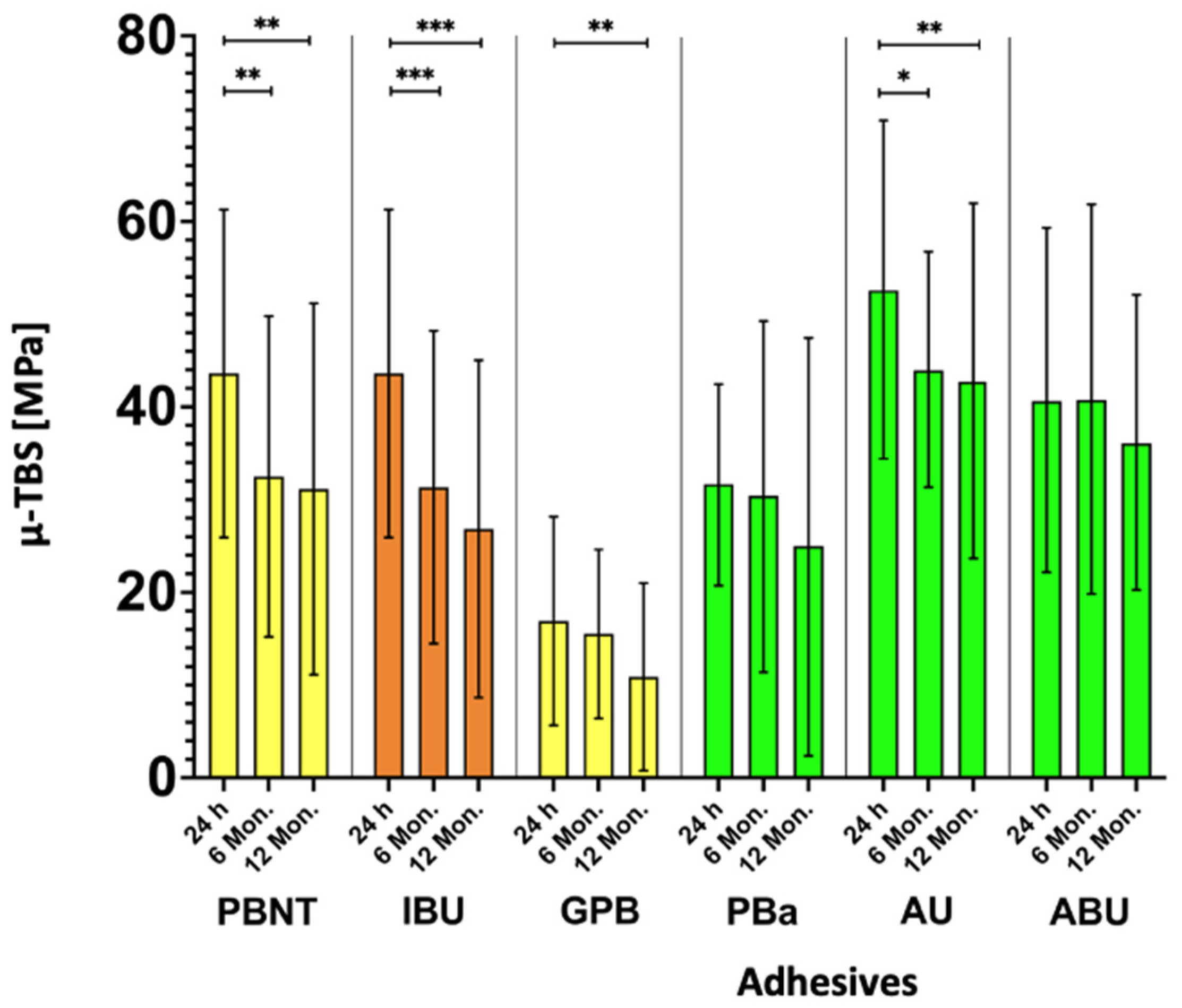



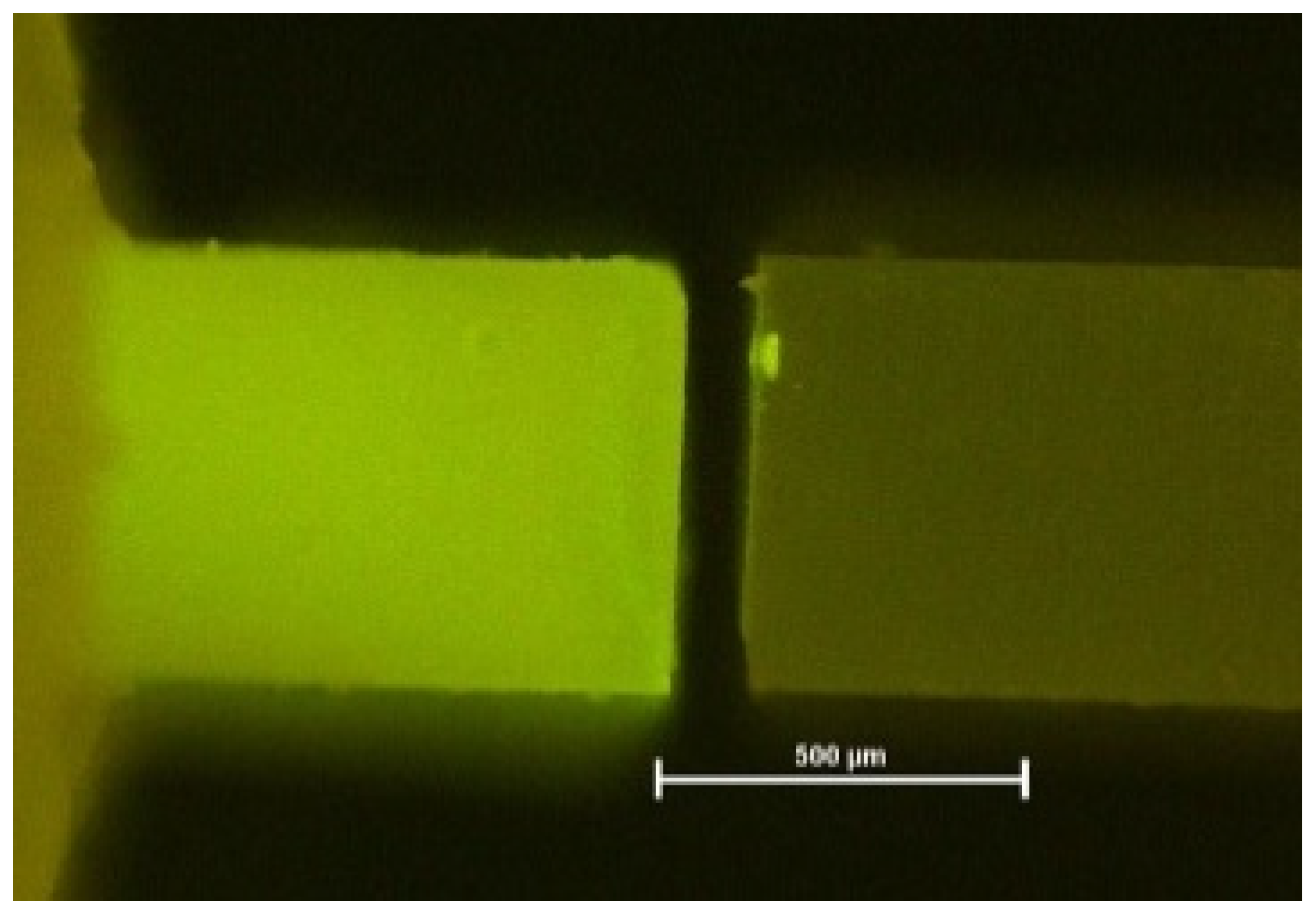

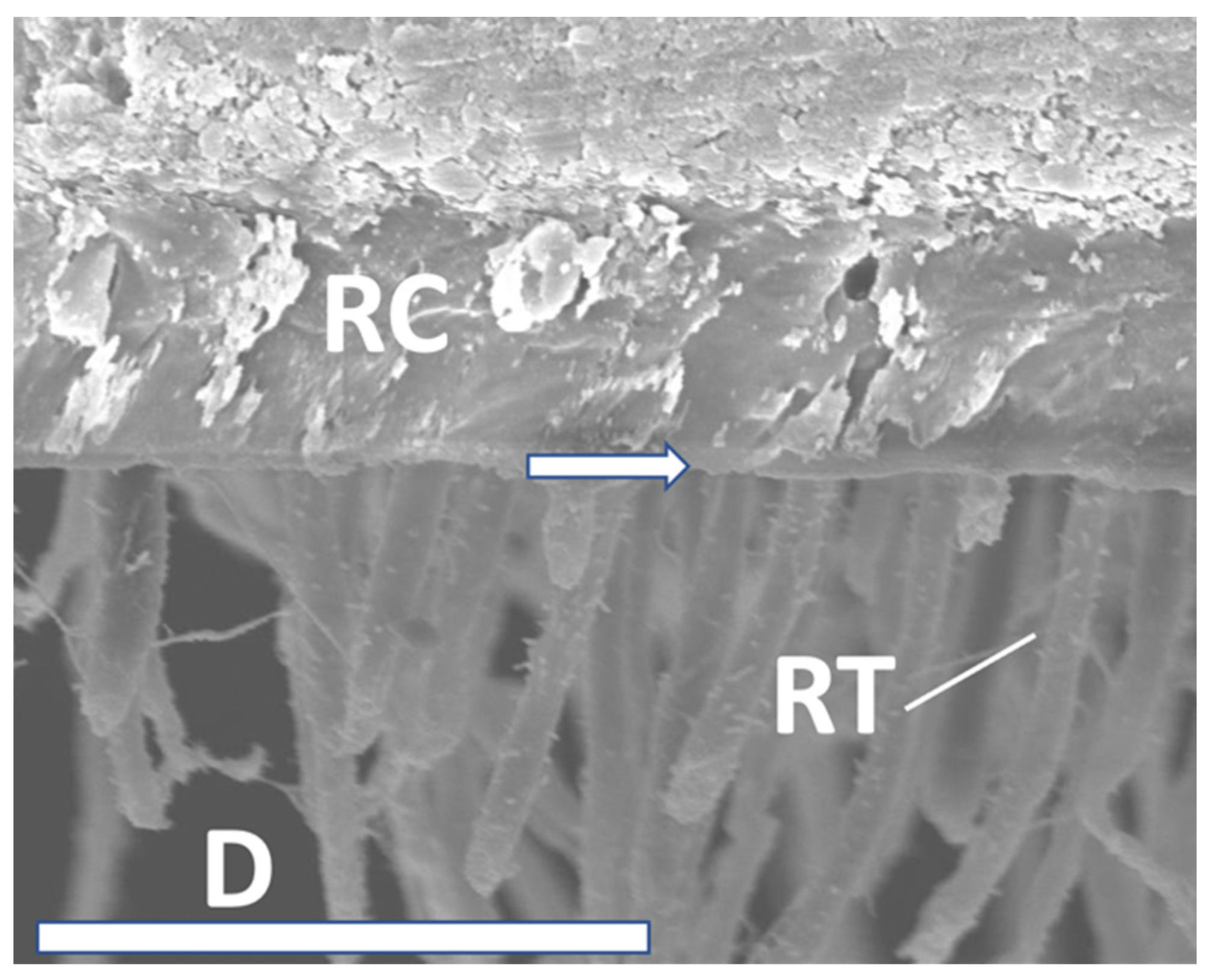

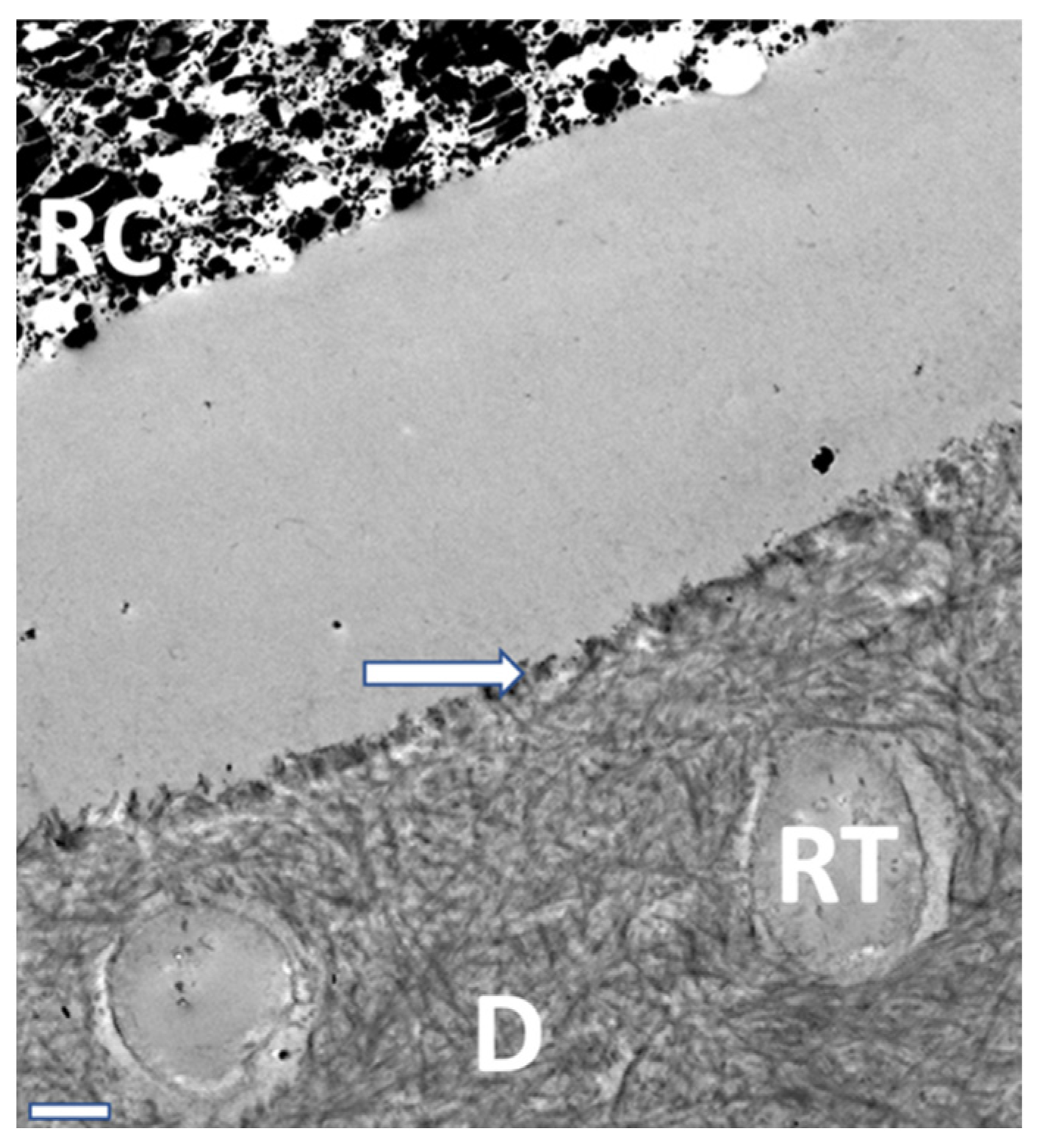
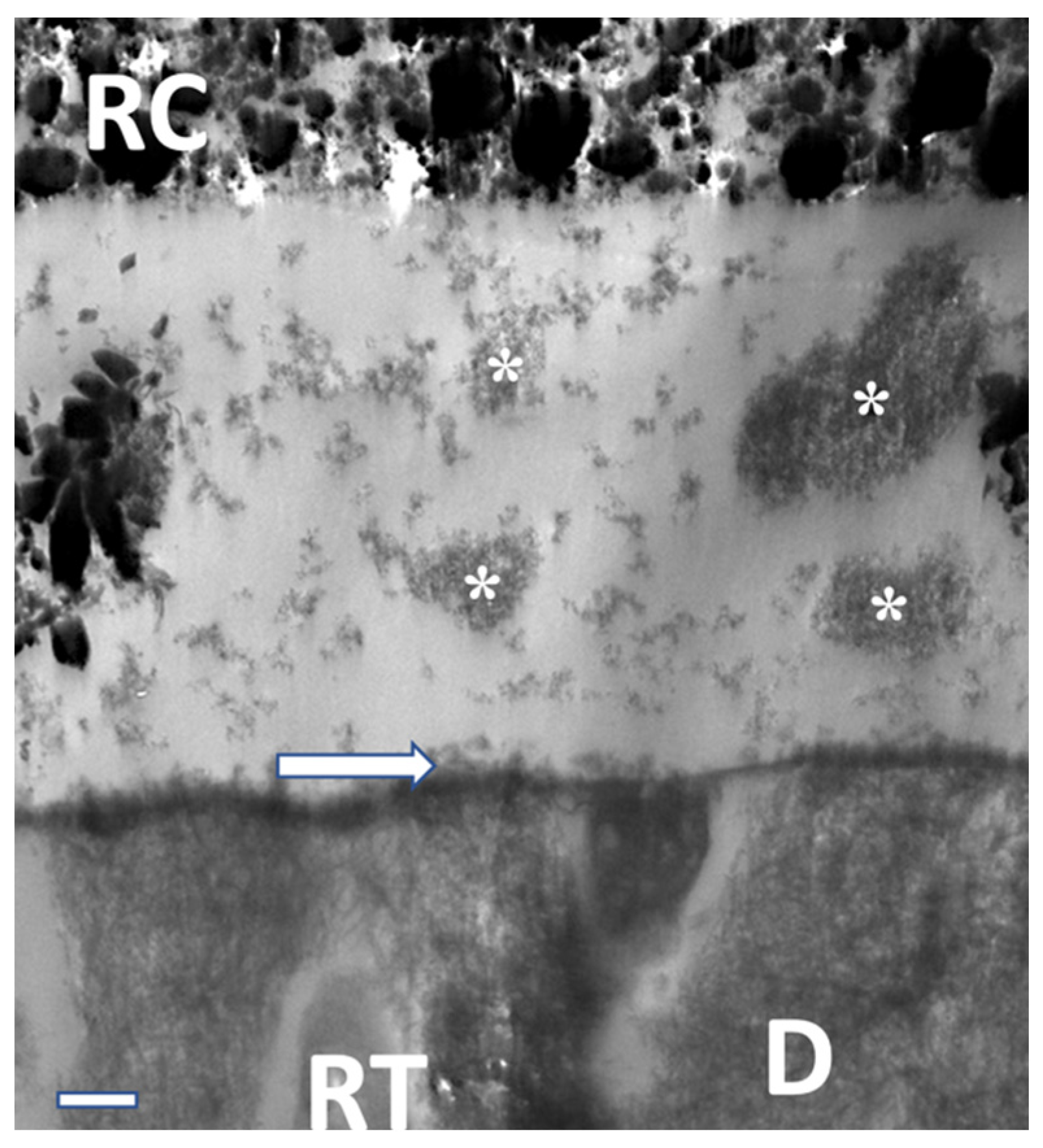
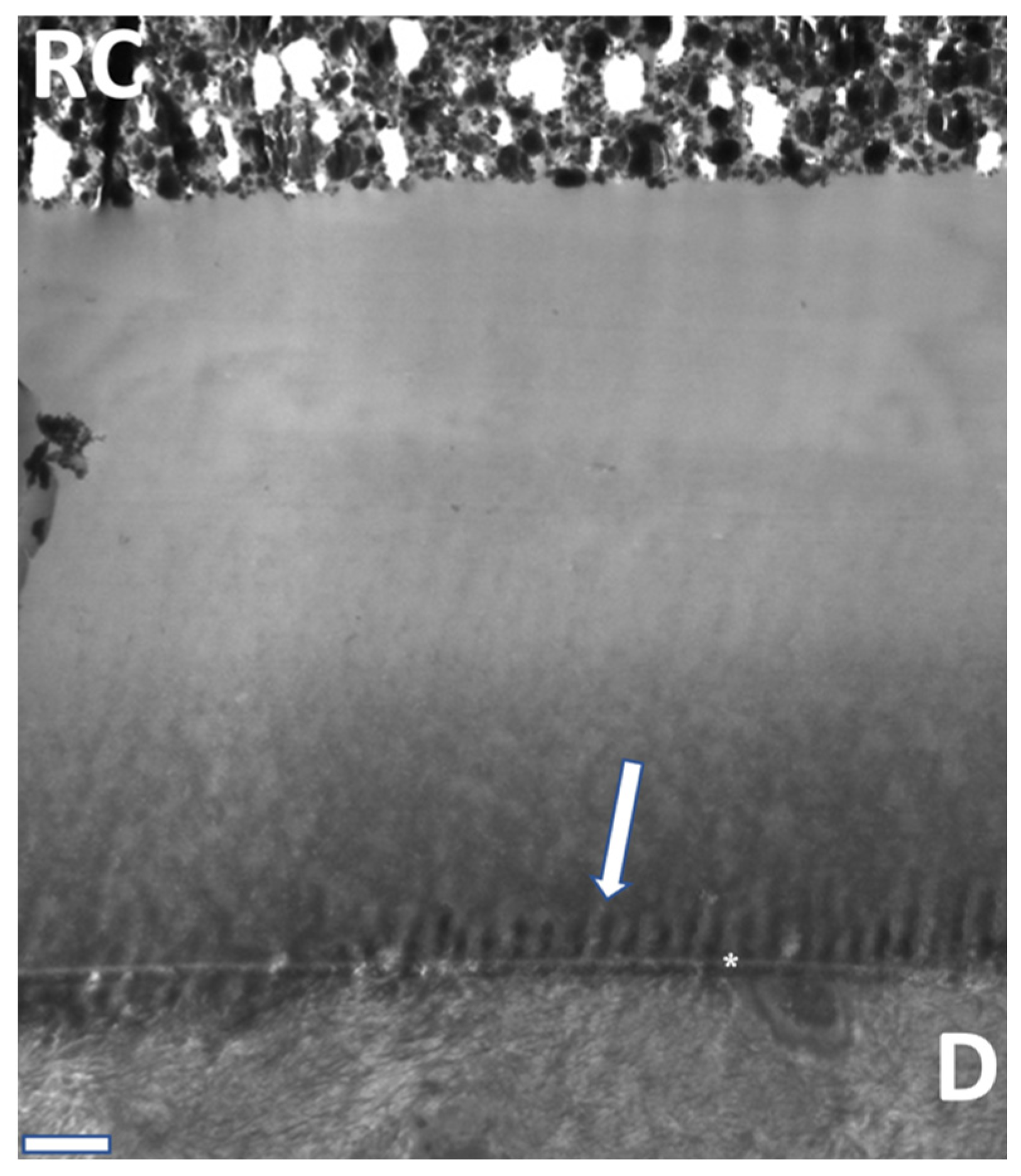
| Classification | pH | Demineralization |
|---|---|---|
| ultra-mild | >2.5 | ~300 nm |
| mild | ~2 | 1 µm |
| medium | 1–2 | 1–2 µm |
| strong | <1 | >2 µm |
| Adhesive | Functional Monomer | Solvent | pH Value | Application |
|---|---|---|---|---|
| Prime & Bond® NT (control) Dentsply Sirona GmbH | UDMA, PENTA | Acetone | 2.1 | (a), (b), (e), (g), (h) |
| iBond® Universal Kulzer Dental GmbH | 10-MDP | Acetone, water | 1.6–1.8 | (a), (b), (e), (f), (h) |
| G-Premio Bond, GC Europe N.V. | 10-MDP | Acetone, 2-Hydroxy-1,3-dimethacryl-oxypropan | 2.1 | (a), (b), (c), (i), (h) |
| Prime & Bond active™ Dentsply Sirona GmbH | 10-MDP | Isopropanol, water | 2.5 | (a), (b), (e), (g), (h) |
| Adhese® Universal, Ivoclar Vivadent | 10-MDP | Ethanol, water | 2.5–3.0 | (a), (b), (e), (h), (j) |
| All-Bond Universal®, Bisco Inc. | 10-MDP | Ethanol, water | 2.5–3.5 | (a), (d), (h), (j) |
| Adhesives/Fracture Mode | Control Group PBNT | IBU | GPB | PBa | AU | ABU | ||||||||||||
|---|---|---|---|---|---|---|---|---|---|---|---|---|---|---|---|---|---|---|
| Storage Period | 24 h | 6 mo | 12 mo | 24 h | 6 mo | 12 mo | 24 h | 6 mo | 12 mo | 24 h | 6 mo | 12 mo | 24 h | 6 mo | 12 mo | 24 h | 6 mo | 12 mo |
| µ-TBS (SD) [MPa] | 43.6 (17.7) | 32.5 (17.3) | 31.2 (20.0) | 44.5 (21.2) | 31.3 (16.9) | 26.9 (18.2) | 16.9 (11.3) | 15.5 (9.1) | 10.9 (10.1) | 31.7 (11.0) | 30.4 (19.0) | 25.0 (22.6) | 52.8 (18.3) | 44.1 (12.8) | 42.9 (19.3) | 40.8 (18.7) | 41.0 (21.1) | 36.3 (16.0) |
| Pre-test failures [%] | 0.0 | 0.0 | 14.6 | 0.0 | 0.0 | 0.0 | 0.0 | 4.9 | 12.2 | 0.0 | 3.4 | 6.2 | 0.0 | 0.0 | 0.0 | 0.0 | 4.4 | 0.0 |
| Adhesive fractures [%] | 78.8 | 97.3 | 85.4 | 96.9 | 93.8 | 97.5 | 100.0 | 95.1 | 87.8 | 92.5 | 93.2 | 86.4 | 83.1 | 94.6 | 86.3 | 81.3 | 73.3 | 88.1 |
| Cohesive fractures [%] | 21.2 | 2.7 | 0.0 | 3.1 | 6.2 | 2.5 | 0.0 | 0.0 | 0.0 | 7.5 | 3.4 | 7.4 | 16.9 | 5.4 | 13.7 | 18.7 | 22.2 | 11.9 |
Disclaimer/Publisher’s Note: The statements, opinions and data contained in all publications are solely those of the individual author(s) and contributor(s) and not of MDPI and/or the editor(s). MDPI and/or the editor(s) disclaim responsibility for any injury to people or property resulting from any ideas, methods, instructions or products referred to in the content. |
© 2023 by the authors. Licensee MDPI, Basel, Switzerland. This article is an open access article distributed under the terms and conditions of the Creative Commons Attribution (CC BY) license (https://creativecommons.org/licenses/by/4.0/).
Share and Cite
Danevitch, N.; Frankenberger, R.; Lücker, S.; Gärtner, U.; Krämer, N. Dentin Bonding Performance of Universal Adhesives in Primary Teeth In Vitro. Materials 2023, 16, 5948. https://doi.org/10.3390/ma16175948
Danevitch N, Frankenberger R, Lücker S, Gärtner U, Krämer N. Dentin Bonding Performance of Universal Adhesives in Primary Teeth In Vitro. Materials. 2023; 16(17):5948. https://doi.org/10.3390/ma16175948
Chicago/Turabian StyleDanevitch, Nina, Roland Frankenberger, Susanne Lücker, Ulrich Gärtner, and Norbert Krämer. 2023. "Dentin Bonding Performance of Universal Adhesives in Primary Teeth In Vitro" Materials 16, no. 17: 5948. https://doi.org/10.3390/ma16175948
APA StyleDanevitch, N., Frankenberger, R., Lücker, S., Gärtner, U., & Krämer, N. (2023). Dentin Bonding Performance of Universal Adhesives in Primary Teeth In Vitro. Materials, 16(17), 5948. https://doi.org/10.3390/ma16175948








